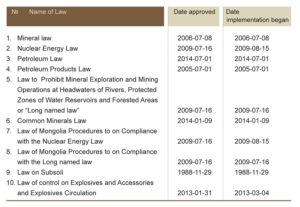Cleaning up laws in the mineral sector
- 2017-09-05
- 739
The list above is of the main laws that govern the mineral sector. They will soon receive a thorough clean-up to remove contradictions and conflicts between them, and to make them more coherent and complementary. The work has been entrusted to a working group set up jointly by the Ministries of Justice and Internal Affairs, and of Mining and Heavy Industry, in pursuance of the Government’s declared intention to make 2017 the year when the overall and total legal environment in the mineral sector would be streamlined.
Quite some progress has already been made. A draft law for regulating mining operations has been prepared, and possible amendments to both the Mineral Law and the Law on Subsoil have been listed. A new “umbrella” mining law is planned, and to give it the required wider outreach, all environment-related laws are being reviewed to remove provisions that generate contradictions and ambiguities. For all this, separate working groups have been set up in the Mining and Heavy Industry Ministry and in the Environmental and Tourism Ministry, and lawyers in both will be fine-combing laws in their ministry to identify provisions likely to cause confusion. The group in the first will look into the ten laws given earlier, and those in the second are now finalising the list of the laws they will scrutinise. The rationale behind the project is that it is better to remove likely sources of conflict than to add new regulations.
A similar exercise was undertaken in 2010, announced as a Year to Reform the Business Environment. Altogether 81 existing laws were chosen for review and overhaul. They were studied to detect duplication, contradiction, and gaps, with the goal being reduction of bureaucracy and simplifying legal requirements. Unfortunately, the draft law that was prepared for removing the legal conflicts after long and hard work was not approved. It was different in the environmental sector, where 18 laws replaced the existing 30, after removing various kinds of inconsistencies. This led to the present clear and systematically prepared set of well rated environmental laws.
The situation with laws in the mineral sector has long been seen as hindering smooth progress but no tangible improvement on the ground has been seen. An attempt was made in 2013 to reform the sector’s “constitution” and there were year-long discussions on the needed changes but there was no convergence of views among the multiple interests. The state policy on the mineral sector adopted in 2014 was the first comprehensive policy document on the sector, raising hopes of follow-up legal reforms, but they were soon dashed.
The demand for a more systematic legal environment persists. The Intergovernmental Forum (IGF) on Mining, Minerals, Metals and Sustainable Development, with over 50 member countries, has found anomalies and uncertainties, as also areas without adequate regulation in the country’s legal environment, after conducting a year-long study for the Mongolian government. Its report is called Mining Policy Framework Assessment: Mongolia and can be read with profit.
The mining sector needs stability, clarity and certainty just as life needs fresh air and water. The ministry has been trying in multiple ways to bring in changes in the legal environment, to ensure the stability that will encourage and reassure both domestic and foreign investors. The first version of the mining law draft was under discussion for four months, which is only to be expected. These are serious matters and quick fixes might fetch applaud but will not do in the long run. Let the process take long, but the end result should be unequivocally good. That way, the present mood is definitely positive and optimistic. We need something permanent to come out from the present exercise, not stopgap measures.
Another important issue covered in our present issue is the relation between a local community and mining companies. We have reported in recent issues on how some individual soums in Dornogovi and Uvs aimags, and the aimags themselves, have been defining their cooperation with mining companies, and this time we cover Umnugobi aimag, the “One tonne resource-one tree” initiative and the agreement with herders where can turn out to be trailblazers.
As for licence owners, they should not forget that a cooperation agreement with the local community is now a legal requirement. Extraction licence owners, starting from next year, will not get their mining plans approved if there is no such agreement in force. The Mineral Resources and Petroleum Authority will have a big database on such agreements, and monitoring their implementation and following the progress of the cooperation would be really useful for both mining companies and local communities.
